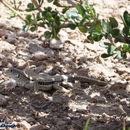en
names in breadcrumbs


Eremias persica, the Aralo-Caspian racerunner[1] or Persian racerunner,[2] is a species of lizard native to southern Azerbaijan, most of Iran, southern Turkmenistan, Afghanistan, and western Pakistan.[1] Eremias intermedia is also known as the Aralo-Caspian racerunner.
It was described by William Thomas Blanford in 1875.[1][3] The type locality is near Isfahan, Iran.[4] The specific epithet persica refers to its distribution in Persia (now known as Iran).[1]
Eremias nigrolateralis Rastegar-Pouyani & Nilson, 1998, the black-sided racerunner,[5] was described based on dorsal color patterning differences but is now considered a synonym of E. persica.[1][2] E. nigrolateralis was considered a species of least concern on the IUCN Red List based on its extensive, suitable habitat, large population, and presumed lack of significant threats.[5] It was considered "unlikely to be declining fast enough to qualify for listing in a more threatened category".[5] E. persica has not been separately assessed on the IUCN Red List.[6]
It is most closely related to Eremias velox, of which it was previously treated as a subspecies, and they share several attributes such as having a wide range distribution across the Iranian Plateau, as well as the number of and shape of their scales.[7][1] It can be morphologically distinguished from E. velox based on several characteristics, including:
Like many other lacertid lizards, the juveniles are more easily distinguished from other species than the adults.[2] Other closely related species of Eremias racerunners include E. kopetdaghica, E. isfahanica, E. lalezharica, E. montana, E. papenfussi, E. strauchi, and E. suphani.[7]
The Persian racerunner occurs in Iran, southern Azerbaijan, southern Turkmenistan, Afghanistan, and western Pakistan.[4] In Iran, Eremias persica has a broad distribution in the central plateau south of the Alborz Mountains, including the Zagros Mountains, but it is absent from the central deserts Dasht-e Lut and Dasht-e Kavir.[4] It is found in open plains and slopes, typically in areas of low vegetation and gravel surfaces. It is also found on mixed sand or silt and gravel.[4]
Eremias persica, the Aralo-Caspian racerunner or Persian racerunner, is a species of lizard native to southern Azerbaijan, most of Iran, southern Turkmenistan, Afghanistan, and western Pakistan. Eremias intermedia is also known as the Aralo-Caspian racerunner.